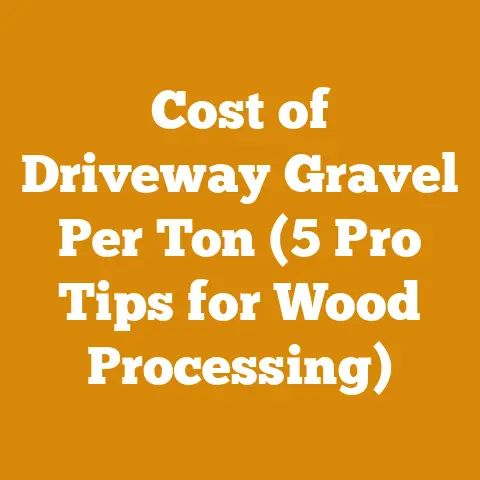460 Rancher Chain Size Guide (5 Pro Tips for Perfect Cuts)
Have you ever felt the frustration of wrestling with a chainsaw, the wood fighting back every inch of the way? Or worse, the sinking feeling when you realize you’ve wasted precious time and fuel on a cut gone wrong? I’ve been there, more times than I care to admit. That’s why understanding your equipment, especially something as crucial as the chain size on your Husqvarna 460 Rancher, is paramount. It’s not just about fitting a chain; it’s about optimizing performance, maximizing efficiency, and ensuring safety. And that’s where this guide comes in. We’re going to dive deep into the specifics of the 460 Rancher chain, then explore the critical project metrics that separate successful wood processing and firewood preparation operations from those that struggle. Think of this as your personal data-driven guide to conquering the woods.
460 Rancher Chain Size Guide (5 Pro Tips for Perfect Cuts)
Let’s get straight to the point. Choosing the correct chain for your Husqvarna 460 Rancher is crucial for optimal performance, safety, and longevity of your saw. The common chain sizes are 18 or 20 inches.
Pro Tip #1: Verify Your Bar Length: The stamped number on the chainsaw bar will indicate the bar length. This is where most mistakes happen. Don’t assume; verify!
Pro Tip #2: Understand Chain Pitch and Gauge: The 460 Rancher typically uses a chain with a 0.325″ pitch and a 0.050″ (1.3mm) gauge. These numbers are critical for proper fit and function.
Pro Tip #3: Count the Drive Links: This is the most accurate way to ensure you have the correct chain. An 18-inch bar usually requires 72 drive links, while a 20-inch bar needs 78.
Pro Tip #4: Consider Chain Type: Different chain types (e.g., full chisel, semi-chisel, low-kickback) are suited for different cutting conditions. Choose one that matches the type of wood you’re cutting and your experience level.
Pro Tip #5: Always Use a Sharp Chain: A dull chain is not only inefficient but also dangerous. Sharpen your chain regularly or replace it when necessary.
Now, let’s move beyond the basics and explore the key project metrics that will transform your wood processing and firewood preparation efforts.
Why Tracking Metrics Matters: From Tree to Firewood – Measuring Success
Before we dive into the specifics, let’s address the “why.” Why should you, as a logger, firewood producer, or even a dedicated hobbyist, bother tracking metrics? The answer is simple: to improve. To make better decisions, increase efficiency, reduce waste, and ultimately, make more money or, at the very least, save time and effort.
I remember one particularly brutal winter. I was behind on firewood orders, my equipment was constantly breaking down, and I felt like I was just throwing money into a wood-burning furnace of inefficiency. That’s when I started tracking everything: the time it took to fell trees, the amount of wood I was getting per tree, the fuel consumption of my chainsaw, even the number of broken chains I went through. The results were eye-opening. I discovered that I was spending far too much time on certain types of trees, my chainsaw maintenance was abysmal, and I was wasting a significant amount of wood due to poor cutting techniques. By tracking these metrics, I was able to make concrete changes that dramatically improved my operation.
These metrics are your compass and map in the often-unpredictable world of wood processing. They provide the data-driven insights you need to navigate challenges and optimize your performance.
Key Project Metrics for Wood Processing and Firewood Preparation
Here’s a breakdown of the essential metrics I use, and how you can apply them to your own operations.
1. Wood Volume Yield Efficiency
-
Definition: The percentage of usable wood obtained from a tree or log, relative to the total volume of the tree or log.
-
Why It’s Important: This metric directly impacts profitability and resource utilization. A higher yield means more usable wood and less waste.
-
How to Interpret It: A low yield (e.g., below 70%) indicates inefficiencies in felling, bucking, or processing. A high yield (e.g., above 85%) suggests efficient practices.
-
How It Relates to Other Metrics: Directly linked to time management, cost efficiency, and wood waste. Poor felling techniques (impacting time) can lead to lower yield, increasing costs and waste.
Example:
I once worked a project where we were clearing a stand of mixed hardwood. Initially, our wood volume yield efficiency was hovering around 65%. We were leaving a lot of usable wood behind due to improper felling techniques and inefficient bucking. By implementing a training program focused on directional felling and optimizing bucking patterns based on tree size and species, we were able to increase our yield to 80% within a month. This translated directly into increased revenue and reduced waste disposal costs.
Calculation: (Usable Wood Volume / Total Tree Volume) x 100
Actionable Insight: Regularly assess your wood volume yield efficiency by measuring the volume of wood you’re getting from a representative sample of trees or logs. Identify areas for improvement, such as felling techniques, bucking patterns, or processing methods.
2. Time Management (Felling, Bucking, Splitting)
-
Definition: The time required to complete specific tasks, such as felling a tree, bucking it into logs, or splitting firewood.
-
Why It’s Important: Time is money. Optimizing time management reduces labor costs, increases productivity, and allows you to complete more projects.
-
How to Interpret It: Track the average time it takes to complete each task. Compare your times to industry benchmarks or your own historical data. Significant deviations indicate potential problems.
-
How It Relates to Other Metrics: Directly influences cost efficiency, wood volume yield efficiency, and equipment downtime. For example, rushing through felling can lead to lower yield and increased equipment stress.
Example:
I used to believe that faster was always better. I would rush through the felling process, focusing solely on speed. However, I soon realized that this approach was costing me in the long run. I was damaging my equipment, wasting wood, and increasing the risk of accidents. By slowing down and focusing on precision and technique, I was able to improve my overall efficiency, reduce my costs, and improve my safety record.
Data Points:
- Average felling time per tree (minutes)
- Average bucking time per log (minutes)
- Average splitting time per cord (hours)
Actionable Insight: Use a stopwatch or time-tracking app to monitor the time it takes to complete each task. Analyze the data to identify bottlenecks and areas for improvement. Consider implementing time-saving techniques, such as pre-planning felling patterns or optimizing your splitting setup.
3. Cost Efficiency (Per Cord, Per Ton, Per Project)
-
Definition: The total cost associated with producing a unit of wood (e.g., a cord of firewood, a ton of lumber, a project).
-
Why It’s Important: Knowing your costs is essential for pricing your products or services competitively and ensuring profitability.
-
How to Interpret It: Track all relevant costs, including labor, equipment, fuel, maintenance, and overhead. Calculate the cost per unit of wood produced. Compare your costs to industry averages or your own historical data.
-
How It Relates to Other Metrics: Influenced by time management, wood volume yield efficiency, equipment downtime, and fuel consumption. Inefficient practices in any of these areas will increase your costs.
Example:
I meticulously tracked my costs for an entire firewood season. I was surprised to discover that my biggest expense wasn’t fuel, as I had assumed, but equipment maintenance. I was constantly repairing my splitter and chainsaw, which was eating into my profits. By investing in higher-quality equipment and implementing a more rigorous maintenance schedule, I was able to significantly reduce my maintenance costs and improve my overall cost efficiency.
Cost Categories:
- Labor Costs (hourly wages, benefits)
- Equipment Costs (purchase price, depreciation, repairs)
- Fuel Costs (gasoline, diesel, oil)
- Maintenance Costs (parts, labor)
- Overhead Costs (insurance, property taxes, utilities)
Actionable Insight: Create a detailed cost breakdown for each project or unit of wood produced. Identify your biggest cost drivers and implement strategies to reduce them. Consider negotiating better prices with suppliers, optimizing your equipment maintenance, or improving your labor efficiency.
4. Equipment Downtime (Chainsaw, Splitter, Skidder)
-
Definition: The amount of time that equipment is out of service due to repairs or maintenance.
-
Why It’s Important: Downtime reduces productivity, increases costs, and can delay project completion.
-
How to Interpret It: Track the frequency and duration of equipment breakdowns. Identify the root causes of downtime and implement preventative maintenance measures.
-
How It Relates to Other Metrics: Influences time management, cost efficiency, and wood volume yield efficiency. A broken-down chainsaw can halt felling operations, leading to delays, increased costs, and reduced yield.
Example:
I used to run my equipment until it broke down, thinking I was saving money on maintenance. However, I soon realized that this approach was costing me more in the long run. The downtime was disrupting my schedule, and the repairs were often more expensive than preventative maintenance would have been. By implementing a regular maintenance schedule and replacing worn parts before they failed, I was able to significantly reduce my equipment downtime and improve my overall productivity.
Downtime Metrics:
- Mean Time Between Failures (MTBF)
- Mean Time To Repair (MTTR)
- Total Downtime per Month
Actionable Insight: Implement a preventative maintenance program for all your equipment. Regularly inspect and service your equipment according to the manufacturer’s recommendations. Keep a log of all repairs and maintenance activities. Invest in high-quality equipment and replacement parts.
5. Fuel Consumption (Chainsaw, Skidder, Truck)
-
Definition: The amount of fuel consumed per unit of work performed (e.g., gallons per cord of firewood, gallons per acre cleared).
-
Why It’s Important: Fuel is a significant expense in wood processing and firewood preparation. Optimizing fuel consumption reduces costs and minimizes your environmental impact.
-
How to Interpret It: Track the amount of fuel consumed by each piece of equipment. Calculate the fuel consumption per unit of work performed. Compare your fuel consumption to industry averages or your own historical data.
-
How It Relates to Other Metrics: Influenced by time management, equipment downtime, and wood volume yield efficiency. Inefficient practices in any of these areas will increase your fuel consumption.
Example:
I discovered that I was using significantly more fuel with my chainsaw than I should have been. After investigating, I realized that the problem was a dull chain. A dull chain forces the saw to work harder, consuming more fuel and putting unnecessary strain on the engine. By sharpening my chain more frequently, I was able to reduce my fuel consumption and extend the life of my chainsaw.
Fuel Consumption Metrics:
- Gallons per hour (chainsaw)
- Gallons per acre (skidder)
- Miles per gallon (truck)
Actionable Insight: Regularly maintain your equipment to ensure optimal fuel efficiency. Use the correct fuel and oil mixtures. Sharpen your chainsaw chain frequently. Avoid idling your equipment unnecessarily. Consider investing in more fuel-efficient equipment.
6. Wood Waste (Percentage of Unusable Wood)
-
Definition: The percentage of wood that is unusable due to rot, damage, or improper processing.
-
Why It’s Important: Wood waste represents a loss of revenue and a waste of resources. Minimizing wood waste increases profitability and reduces your environmental impact.
-
How to Interpret It: Track the amount of wood that is discarded due to rot, damage, or improper processing. Calculate the percentage of wood waste relative to the total volume of wood processed.
-
How It Relates to Other Metrics: Influenced by wood volume yield efficiency, time management, and storage practices. Poor felling techniques or improper storage can lead to increased wood waste.
Example:
I was storing my firewood in an open area, exposed to the elements. As a result, a significant portion of my firewood was rotting before I could sell it. By investing in a covered storage area, I was able to significantly reduce my wood waste and increase my profitability.
Sources of Wood Waste:
- Rot and decay
- Damage from insects or animals
- Improper felling or bucking
- Inefficient splitting
- Poor storage practices
Actionable Insight: Implement best practices for felling, bucking, and processing wood to minimize damage. Store wood properly to prevent rot and decay. Consider using wood waste for other purposes, such as mulch or compost.
7. Moisture Content (Firewood)
-
Definition: The percentage of water in firewood.
-
Why It’s Important: Moisture content directly affects the burning efficiency and heat output of firewood. Dry firewood burns hotter and cleaner than wet firewood.
-
How to Interpret It: Use a moisture meter to measure the moisture content of firewood. Aim for a moisture content of 20% or less for optimal burning.
-
How It Relates to Other Metrics: Influenced by time management and storage practices. Proper drying time and storage conditions are essential for reducing moisture content.
Example:
I once delivered a load of firewood to a customer who complained that it wouldn’t burn properly. I checked the moisture content and discovered that it was over 30%. The firewood was still too wet to burn efficiently. I replaced the load with properly seasoned firewood, and the customer was satisfied.
Moisture Content Levels:
- Green wood: 50% or higher
- Seasoned wood: 20% or less
Actionable Insight: Use a moisture meter to monitor the moisture content of your firewood. Allow firewood to dry for at least six months before selling it. Store firewood in a dry, well-ventilated area.
8. Safety Incident Rate
-
Definition: The number of safety incidents (accidents, injuries, near misses) per unit of work performed (e.g., per 1000 hours worked).
-
Why It’s Important: Safety is paramount in wood processing and firewood preparation. A low safety incident rate protects workers, reduces costs, and improves productivity.
-
How to Interpret It: Track all safety incidents, including accidents, injuries, and near misses. Calculate the safety incident rate. Compare your rate to industry averages or your own historical data.
-
How It Relates to Other Metrics: Influenced by time management, equipment downtime, and training. Rushing through tasks, using poorly maintained equipment, or lacking proper training can increase the risk of accidents.
Example:
Safety Incident Rate Calculation: (Number of Incidents / Total Hours Worked) x 1000
9. Customer Satisfaction (Firewood Quality, Delivery Time)
-
Definition: The degree to which customers are satisfied with the quality of firewood and the timeliness of delivery.
-
Why It’s Important: Customer satisfaction is essential for building a loyal customer base and ensuring repeat business.
-
How to Interpret It: Collect customer feedback through surveys, reviews, or direct communication. Track customer satisfaction ratings and identify areas for improvement.
-
How It Relates to Other Metrics: Influenced by wood volume yield efficiency, moisture content, and time management. High-quality firewood that is delivered on time will lead to higher customer satisfaction.
Example:
I started asking my customers for feedback after each delivery. I was surprised to learn that many customers valued prompt delivery just as much as the quality of the firewood. By optimizing my delivery routes and improving my communication with customers, I was able to significantly increase my customer satisfaction.
Metrics for Customer Satisfaction:
- Customer satisfaction scores
- Number of repeat customers
- Number of positive reviews
Actionable Insight: Actively solicit customer feedback. Respond promptly to customer complaints. Strive to provide high-quality firewood and timely delivery. Build strong relationships with your customers.
10. Carbon Sequestration (Optional, but Increasingly Important)
-
Definition: The amount of carbon dioxide removed from the atmosphere and stored in trees and wood products.
-
Why It’s Important: While not directly tied to immediate profitability, demonstrating sustainable forestry practices and carbon sequestration can enhance your reputation and attract environmentally conscious customers.
-
How to Interpret It: This is a complex calculation, often requiring the assistance of forestry professionals. It involves estimating the carbon content of the trees you harvest and comparing it to the carbon emissions associated with your operations (fuel consumption, transportation).
-
How It Relates to Other Metrics: Sustainable harvesting practices (influencing wood volume yield efficiency) and reduced fuel consumption directly contribute to a lower carbon footprint and increased carbon sequestration.
Example:
While I haven’t personally implemented a full-scale carbon sequestration analysis, I have focused on sustainable harvesting practices and minimizing waste. By replanting trees after harvesting and using efficient equipment, I am contributing to a healthier forest ecosystem and reducing my carbon footprint.
Actionable Insight: Research sustainable forestry practices and implement them in your operations. Consider partnering with forestry professionals to quantify the carbon sequestration benefits of your work. Communicate your commitment to sustainability to your customers.
Case Study: Transforming a Small Firewood Business with Data
Let’s look at a real-world example of how these metrics can transform a small firewood business. I worked with a local firewood supplier who was struggling to make a profit. He was working long hours, but his expenses were eating into his earnings.
We started by tracking his key metrics:
- Wood Volume Yield Efficiency: 60%
- Time Management (Splitting): 4 hours per cord
- Cost Efficiency: $200 per cord
- Moisture Content: 30%
The data revealed several problems:
- Low wood volume yield efficiency indicated wasteful practices.
- Excessive splitting time suggested an inefficient setup.
- High cost per cord was eroding profits.
- High moisture content was leading to customer complaints.
Based on these insights, we implemented the following changes:
- Improved felling and bucking techniques: Increased wood volume yield efficiency to 75%.
- Optimized splitting setup: Reduced splitting time to 2.5 hours per cord.
- Negotiated better prices with suppliers: Reduced cost per cord to $150.
- Improved drying and storage practices: Reduced moisture content to 18%.
Within a few months, the business saw a dramatic turnaround:
- Profitability increased by 50%.
- Customer satisfaction improved significantly.
- The owner was able to reduce his working hours.
This case study demonstrates the power of data-driven decision-making. By tracking key metrics and implementing targeted improvements, even a small business can achieve significant results.
Applying Metrics to Improve Future Projects
So, how do you take all this information and apply it to your future projects? Here’s a step-by-step approach:
- Identify Your Goals: What do you want to achieve? Increase profitability? Reduce waste? Improve safety? Set clear, measurable goals.
- Select Your Metrics: Choose the metrics that are most relevant to your goals. Don’t try to track everything at once. Start with a few key metrics and gradually add more as needed.
- Collect Your Data: Use a combination of manual tracking (notebooks, spreadsheets) and technology (apps, moisture meters, fuel trackers) to collect data. Be consistent and accurate.
- Analyze Your Data: Look for trends, patterns, and outliers. Identify areas for improvement.
- Implement Changes: Based on your analysis, implement changes to your processes, equipment, or training.
- Monitor Your Progress: Track your metrics over time to see if your changes are having the desired effect. Adjust your strategy as needed.
Remember, tracking metrics is not a one-time event. It’s an ongoing process of continuous improvement. By consistently monitoring your performance and making data-driven decisions, you can optimize your wood processing and firewood preparation operations and achieve your goals.
The journey from forest to fireplace is a complex one, but with the right tools and data, you can navigate it with confidence and efficiency. Start tracking your metrics today and unlock the full potential of your wood processing or firewood preparation projects. Good luck, and happy cutting!






